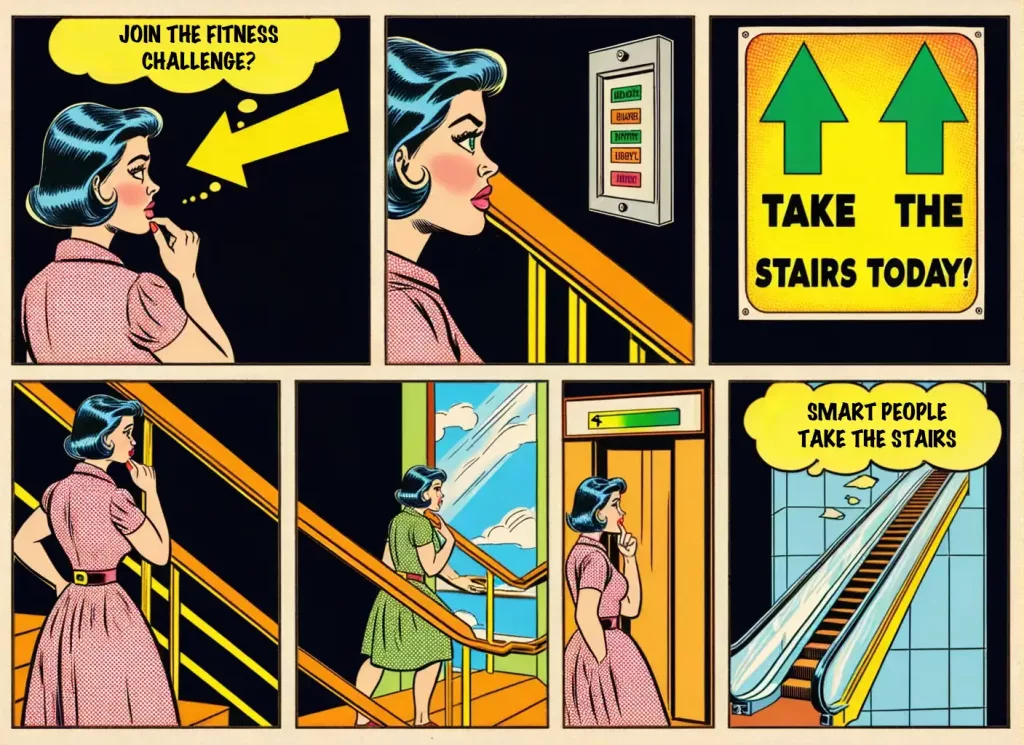Welcome to the intriguing world of Nudge Theory, a concept that has quietly revolutionized the way we make decisions, big and small. Imagine walking into a cafeteria and choosing a salad over a slice of pizza, not because of a sudden burst of willpower, but because the salad was simply more accessible. Or consider the moment you decided to enroll in a pension plan because, well, it was the default option. These scenarios illustrate the subtle power of nudges—small design changes in the environment that can significantly influence our behavior in a predictable way, without forbidding any options or significantly changing their costs.
Table of Contents
- Introduction to Nudge Theory
- The Spectrum of Nudges
- Ethical Considerations: The Good, The Bad, and The Ugly of Nudging
- When a Nudge Becomes a Shove: The Blurred Lines of Influence
- Exploring Alternatives: Boosting and Other Behavioral Techniques
- Conclusion: Nudging Towards a Better Future
- Free 52-page Human Behavior Guide
- References
Introduction to Nudge Theory
What is Nudge Theory?
At its core, Nudge Theory proposes a novel approach to decision-making. It suggests that by understanding how people think and make decisions, policymakers and designers can help steer people toward better choices by making those choices easier, more accessible, and more appealing, all without eliminating freedom of choice.
The Origins: Thaler and Sunstein’s Contribution
The term “nudge” was popularized by Nobel laureate Richard H. Thaler and legal scholar Cass R. Sunstein in their groundbreaking book, Nudge: Improving Decisions About Health, Wealth, and Happiness. They argue that by understanding the biases and heuristics that influence human behavior, it’s possible to design environments that make it easier for people to choose what is best for them, their communities, and even the planet.
Nudge Theory in a Nutshell: Making Choices Easier
Nudge Theory operates on the principle that small changes in the way options are presented can have a disproportionate effect on the choices people make. These nudges take advantage of our cognitive biases, such as our tendency to stick with the default option or our susceptibility to social norms, to guide us toward better decisions. Importantly, nudges are not mandates. They maintain freedom of choice, subtly guiding us without limiting our options.
From the design of user-friendly forms that encourage us to sign up for organ donation, to the placement of healthier foods at eye level to promote better eating habits, nudges are everywhere. They represent a fascinating blend of psychology, economics, and design thinking, aiming to improve our lives in a multitude of small but significant ways.

As we embark on this journey through the many colors of Nudge Theory, from its most playful applications to its most impactful, we invite you to keep an open mind. Nudge Theory not only offers a lens through which to view the world and understand human behavior but also presents a toolkit for making that world a better place, one small nudge at a time.
The Spectrum of Nudges
Nudge Theory isn’t just about the big, life-changing decisions; it’s also found in the small, clever tweaks that make our daily lives better, often in ways we hardly notice. This section unveils some of the most unique and lesser-known nudges that have had surprising impacts. These unheard gems showcase the creativity behind nudge theory and its broad application across different aspects of life.
Everyday life nudges
The Smiley Face Experiment: Reducing Electricity Usage
In an innovative approach to reduce electricity consumption, a utility company in the United States sent out electricity bills to different groups of customers. One group received bills with generic information about their energy usage, while another received the same bill but with a simple addition: a smiley face next to their usage figures if they had consumed less energy than their neighbors [1]. This seemingly trivial addition led to a significant reduction in energy consumption among the recipients of the smiley faces. This nudge exploited social norms and the desire for social approval to encourage energy-saving behavior, proving that sometimes, a smile (or the promise of one) can be a powerful motivator.
Text Reminders for Library Books: Combating Overdue Returns
Libraries, essential bastions of knowledge and learning, often face the challenge of overdue book returns. To tackle this, some libraries have started sending out text reminders to borrowers a few days before their books are due. This simple reminder not only helps reduce the number of overdue books but also encourages a more responsible borrowing behavior. By leveraging the timely nudge of a text message, libraries enhance convenience for users and improve the availability of books for the community [2].
Color-Coded Bins: Enhancing Waste Separation and Recycling Efforts
In an effort to improve waste separation and recycling, some cities have introduced color-coded bins for different types of waste: green for compostable, blue for recyclable, and black for landfill waste. This visual nudge simplifies the decision-making process for residents, making it easier for them to sort their waste correctly [3]. By reducing the cognitive load and making the right choice the easy choice, color-coded bins have significantly increased recycling rates and decreased contamination in recyclables.
These examples demonstrate the versatility and creativity of nudges in prompting better decision-making and behavior change. From leveraging social norms and desires for positive reinforcement to simplifying choices and enhancing convenience, these unheard gems of Nudge Theory illustrate its potential to foster significant improvements in a wide array of everyday activities. As we delve deeper into more serious applications, remember that the essence of nudging lies in its subtle yet powerful ability to make the better choice the easier choice, without ever removing freedom of choice.
Nudges with Profound Consequences
While the unheard gems of Nudge Theory offer a glimpse into its inventive and often whimsical side, the framework’s potential for serious, life-altering impact cannot be overstated. From public health initiatives to financial well-being, nudges have been deployed with significant success, addressing some of society’s most pressing challenges. Here, we explore a few examples where nudges have led to meaningful change.
Automatic Enrollment in Pension Plans: Saving for the Future
One of the most impactful applications of Nudge Theory lies in the domain of retirement savings. Traditional pension schemes often require individuals to opt-in, which can lead to lower participation rates due to procrastination or the complexity of the decision-making process. However, by flipping this choice architecture to an opt-out system, where employees are automatically enrolled in pension plans but have the freedom to leave at any time, participation rates have skyrocketed [4]. This nudge leverages the status quo bias—the tendency to stick with the current state or default option—ensuring that more people save for retirement without impeding their freedom to choose not to participate.
Nudging Towards Water Conservation: The Power of Social Comparisons
With water scarcity becoming an increasingly critical issue globally, innovative strategies to promote conservation are essential. Nudge Theory has been successfully applied to encourage water-saving behaviors among consumers. One effective approach has been the use of social comparison feedback in utility bills. Households receive information not only about their own water usage but also how it compares to the average usage in their neighborhood [5].
This nudge leverages the natural human tendency towards conformity and competition, motivating individuals to adopt more water-efficient habits. Unlike traditional methods that might rely on increasing prices or strict regulations, this strategy maintains consumer choice while encouraging a shift towards conservation. Importantly, it has led to a significant reduction in water consumption, with effects persisting over time. By providing a simple, comparative insight, individuals are nudged to reflect on their behavior and consider the broader social impact of their water usage.

Using SMS Reminders to Improve Medication Adherence
Medication non-adherence is a significant challenge in healthcare, leading to worse outcomes for patients and increased costs for healthcare systems. A simple yet effective nudge to address this issue has been the use of SMS reminders. Patients receive text messages reminding them to take their medication at the prescribed times [6]. This nudge has been shown to significantly improve adherence rates, leveraging the ubiquity of mobile phones and the effectiveness of timely, personalized reminders.

These examples illustrate the breadth and depth of Nudge Theory’s application in addressing serious societal issues. By understanding how decision-making can be influenced by the way choices are presented, policymakers and practitioners can implement strategies that lead to better outcomes across a range of domains, from health and wellness to financial security. The success of these serious nudges underscores the power of subtle adjustments in our environment to foster choices that improve individual and collective well-being, demonstrating that even the smallest changes can have profound impacts.
Ethical Considerations: The Good, The Bad, and The Ugly of Nudging
The Paternalism Debate: When is it Too Much?
Nudge Theory, for all its effectiveness in guiding better decision-making, walks a fine line between benign influence and paternalistic intervention. This delicate balance raises a critical ethical question: At what point does nudging become too much, crossing from helpful guidance into intrusive paternalism?
The concept of “libertarian paternalism” underpins Nudge Theory, a term coined by Thaler and Sunstein to describe the balance between guiding choices (the paternalism part) and preserving freedom of choice (the libertarian part) [7]. Proponents argue that nudging is ethically justifiable as it aims to improve people’s decision-making without restricting their freedom. However, critics counter that even well-intentioned nudges can embody a form of soft paternalism, subtly imposing policymakers’ judgments over individuals’ preferences [8].
The debate intensifies around the notion of what constitutes the “best interest” of individuals. Nudges are designed based on assumptions about what choices are in people’s best interests, but these assumptions may not always align with individuals’ values or preferences. For instance, automatically enrolling employees in pension plans assumes that saving for retirement is universally valued, neglecting individual circumstances or preferences that might lead someone to prioritize short-term financial needs over long-term savings [9].
Moreover, the effectiveness of nudges can also depend on who is implementing them and for what purpose. When governments employ nudging strategies, there’s an implicit trust that these are aimed at the public good. However, when used by corporations, the same strategies might aim to maximize profit rather than benefit the consumer, blurring ethical lines and raising concerns over manipulation for commercial gain rather than societal benefit [10].
Transparency emerges as a critical factor in navigating the paternalism debate. For nudges to be ethically sound, they must not only respect freedom of choice but also be transparent about their intentions and mechanisms. This openness allows individuals to understand how and why certain choices are being encouraged, providing an opportunity to critically reflect on these suggestions and opt out if they choose [11].

In summary, while nudging presents a promising tool for improving decision-making and promoting public welfare, it also necessitates a cautious approach to ensure that such interventions remain respectful of individual autonomy and diversity. The challenge lies in designing nudges that are both effective and ethically sound, a task that requires ongoing dialogue, critical assessment, and perhaps most importantly, a commitment to upholding the dignity and freedom of choice of all individuals.
Privacy Concerns and Manipulation: Where Do We Draw the Line?
In the era of big data and digital technology, nudging intersects increasingly with concerns about privacy and the potential for manipulation. The collection and analysis of vast amounts of personal data can enhance the effectiveness of nudges by tailoring them to individual behaviors and preferences. However, this raises significant ethical questions: How much data collection is too much, and when does personalized nudging cross into manipulation?
The utilization of personal data for nudging purposes touches on sensitive privacy issues. Data-driven nudges rely on insights gleaned from individuals’ online activities, purchases, and even social media interactions. While these nudges can be beneficial—such as reminders to take medication or personalized financial saving tips—they also raise concerns about the extent to which organizations have access to and control over personal information [12]. The line between helpful guidance and invasive surveillance becomes blurred, especially when individuals are not fully aware of or have not explicitly consented to the collection and use of their data.
Moreover, the potential for manipulation is a critical concern. When nudges are designed to change behavior in ways that prioritize the nudger’s goals over the individual’s well-being, they can become manipulative. This is particularly troubling in commercial contexts, where companies might use nudges to promote overconsumption or steer consumers towards more profitable, but not necessarily beneficial, options [13]. The ethical line between persuasion and manipulation hinges on transparency, the balance of benefits between the nudger and the nudgee, and the respect for the individual’s autonomy.
The ethical use of nudges, particularly in sensitive areas like health and financial decisions, requires clear consent and an understanding of how personal data will be used. This entails not only upfront transparency but also mechanisms for individuals to control their data and opt out of nudges they find intrusive or misaligned with their values [14]. Ensuring ethical practices in the collection and use of data for nudging necessitates robust privacy protections and a commitment to prioritizing individuals’ interests over those of corporations or governments.
In conclusion, while data-driven nudges offer promising avenues for encouraging beneficial behaviors, they must be navigated with caution to respect privacy and prevent manipulation. Drawing the line requires a principled approach that prioritizes transparency, consent, and the empowerment of individuals to make informed choices about their participation in nudging initiatives. As we advance into the data-rich future, safeguarding these ethical considerations is paramount in harnessing the power of nudges for the public good without compromising the values of privacy and autonomy.
The Importance of Transparency and Consent
Transparency and consent are foundational to the ethical implementation of Nudge Theory, serving as critical safeguards against the risks of overreach and manipulation. These principles ensure that nudging, while designed to influence behavior, respects individual autonomy and promotes trust in those deploying nudges.
Transparency in Nudging involves clear communication about the intent, methodology, and outcomes expected from the nudge. This openness helps demystify the nudge process, allowing individuals to understand how their decisions might be influenced and for what purpose [15]. By elucidating the rationale behind specific nudges, organizations and governments can foster an environment where individuals feel respected and informed, rather than manipulated.
For instance, when a government introduces a nudge to encourage vaccination, transparency about the nudge’s goals (increasing public health), the reasons for its necessity (preventing disease spread), and the mechanisms it employs (reminding citizens of vaccination benefits) is essential. Such transparency not only enhances the effectiveness of the nudge by building public trust but also reinforces the democratic values of openness and accountability.
Consent in Nudging takes transparency a step further, involving individuals in the decision-making process about whether they wish to be nudged in the first place. Consent can be explicit, such as opting into a program that sends reminders for health check-ups, or implicit, in cases where public awareness campaigns ensure that the population knows about the nudge and its benefits, with clear options to opt-out [16]. Ensuring that individuals can consent to or decline participation in nudging initiatives is paramount to maintaining the ethical integrity of such interventions.
Moreover, the dynamic nature of consent implies that preferences and circumstances change, and what was acceptable at one point may no longer be so. Continuous engagement and easy opt-out mechanisms are therefore essential components of ethical nudging practices. This approach respects individual agency, allowing people to reassess their participation as their values or situations evolve.
In essence, transparency and consent function as the ethical pillars of Nudge Theory, ensuring that nudges are implemented in a manner that respects individual dignity and fosters a culture of trust. These principles mitigate concerns over paternalism and manipulation, emphasizing the role of nudges as tools for positive social change that empower rather than coerce. By prioritizing transparency and consent, practitioners of Nudge Theory can navigate the delicate balance between influencing behavior for the common good and preserving the fundamental rights of individuals to make their own choices.
When a Nudge Becomes a Shove: The Blurred Lines of Influence
The nuanced world of behavioral economics where Nudge Theory resides is not without its controversies. While nudges are designed to guide individuals towards better choices without removing freedom, there are instances where the gentle push of a nudge might feel more like a shove. This section delves into concrete cases that illuminate the fine line between helpful nudging and undue manipulation, highlighting the importance of ethical consideration in the application of behavioral insights.

The Case of Overly Persuasive Social Media Algorithms
Social media platforms use algorithms designed to curate content in a way that maximizes user engagement. While this can help tailor user experiences to individual preferences, it also raises questions about manipulation. These algorithms can create echo chambers, reinforcing existing beliefs without exposure to differing viewpoints, and nudging users towards content that may not be in their best interest [17]. The line between personalization and manipulation becomes blurred when users are nudged towards content that maximizes platform profit, possibly at the expense of their well-being or societal cohesion.
Aggressive Marketing Tactics in Consumer Finance
In the realm of consumer finance, certain marketing strategies have nudged consumers towards unfavorable financial products. For example, pre-approved credit card offers make the process of obtaining credit feel effortless, nudging individuals towards potentially high-interest debt. These tactics, while technically offering a choice, can be seen as shoves when they exploit cognitive biases like overconfidence or the allure of instant gratification, pushing individuals towards decisions that may not align with their long-term financial health [18].
Health Insurance Plan Defaults and the Complexity Nudge
A study on health insurance plan choices presented an interesting scenario where the design of the choice architecture could nudge individuals towards suboptimal plans. By setting certain plans as defaults or by making the decision-making process overly complex, entities can manipulate choice without overt coercion. This nudge becomes a shove when individuals, overwhelmed by complexity or swayed by the default, opt for plans that do not best meet their needs, potentially leading to inadequate coverage or higher costs [19].
These cases illustrate the ethical complexities inherent in applying Nudge Theory. When does a helpful hint become a harmful shove? The answer often lies in the intention behind the nudge, the transparency of its application, and the balance of benefits between the nudger and the nudgee. As Nudge Theory continues to evolve, these discussions are crucial in navigating the ethical landscape, ensuring that nudges remain a force for positive influence rather than veiled manipulation. Recognizing and addressing the potential for nudges to overstep their bounds is essential in maintaining the trust and autonomy of individuals, underscoring the need for vigilant ethical oversight in the application of behavioral insights.
Exploring Alternatives: Boosting and Other Behavioral Techniques
While Nudge Theory has garnered significant attention for its ability to influence behavior subtly and ethically, it’s not the only tool in the behavioral science toolbox. Alternatives like “boosting” and other techniques offer different approaches to decision support that prioritize enhancing individual capabilities over changing environmental cues. These methods aim to empower individuals to make better decisions by improving their skills, knowledge, and decision-making competencies.
Boosting: Empowering Decision-Making
Boosting is a concept introduced by Hertwig and Grüne-Yanoff, which focuses on strengthening individuals’ decision-making competencies [20]. Unlike nudges, which alter the choice architecture to guide behavior in a certain direction, boosts aim to enhance individuals’ ability to make their own informed choices. For example, financial literacy programs that teach people how to budget effectively empower them to make better financial decisions without altering the financial products available to them. Boosting advocates for interventions that are transparent, educative, and respect individual autonomy, thereby equipping people with the tools to navigate complex decisions more effectively.
Other Behavioral Techniques: Commitment Devices and Defaults
Beyond nudges and boosts, other behavioral techniques have shown promise in influencing decision-making. Commitment devices, for instance, allow individuals to pre-commit to a decision or course of action to help adhere to long-term goals. This technique leverages the understanding that people often struggle with self-control and might make decisions that are not in their long-term best interest [21]. An example of a commitment device might be a savings account that penalizes withdrawals, helping individuals commit to their savings goals.
Defaults, while a staple of Nudge Theory, can also be seen as a standalone behavioral technique. Defaults work on the principle that people tend to stick with pre-set options, and carefully choosing these can guide individuals towards beneficial behaviors without restricting their freedom of choice [22]. The ethical use of defaults requires that they are designed with the individual’s best interest in mind and that individuals are aware of and can easily change the default setting.
The Importance of Choice Architecture in Behavioral Techniques
All these behavioral techniques—nudging, boosting, commitment devices, and defaults—highlight the critical role of choice architecture in decision-making. The way choices are presented, the information provided, and the options available all significantly impact behavior. However, each technique approaches the challenge of improving decision-making differently, with nudges altering the environment, boosts enhancing individual decision-making skills, and commitment devices and defaults leveraging psychological tendencies to facilitate better choices.
In exploring alternatives to nudging, it’s clear that no single approach is universally superior. The choice between nudging, boosting, and other techniques should be guided by the specific context, the nature of the decision, and the goals of the intervention. By understanding and employing a diverse range of behavioral techniques, policymakers, educators, and organizations can more effectively support individuals in making decisions that enhance their well-being and lead to more positive outcomes for society as a whole.
Conclusion: Nudging Towards a Better Future
As we reflect on the journey through the intricacies of Nudge Theory and its myriad applications, from the whimsical to the profoundly impactful, it becomes evident that nudging represents a potent tool in the behavioral science toolkit. Through the lens of case studies, ethical debates, and alternative approaches, we’ve explored how subtle environmental cues can guide better decision-making, promoting the welfare of individuals and society alike.
Nudge Theory, at its heart, is underpinned by the noble intention of doing good—of gently guiding people towards choices that enhance their well-being, health, financial security, and more, all while preserving their freedom to choose. The discussions around the ethical considerations of nudging, including the debates over paternalism, privacy concerns, and the fine line between influence and manipulation, underscore the responsibility that comes with wielding such a tool. These considerations remind us that the ultimate goal of nudging should always be to empower individuals, not constrain them.
Further research into human behavior, particularly into our unconscious and emotion-driven decision-making processes, holds promise for even greater societal benefits. Understanding the deep-seated reasons behind our choices allows for the development of more effective nudges and other behavioral interventions that can help individuals overcome behaviors they struggle to control. In this realm, the role of biometric research tools, such as iMotions Lab and various biosensors, becomes invaluable. These technologies offer insights into the physiological and emotional underpinnings of decision-making, providing a richer, more nuanced understanding of human behavior.
As we stand on the precipice of future advancements in human behavior research, the potential for nudging and related techniques to contribute to societal well-being is immense. By combining insights from behavioral science with cutting-edge technology, we can develop more nuanced, effective interventions that respect individual autonomy and promote good. This fusion of knowledge and technology not only enhances our ability to guide positive behavior change but also deepens our understanding of the complex tapestry of human decision-making.
In conclusion, Nudge Theory and its exploration through ethical lenses, alternative approaches, and the potential of biometric research highlight a future where behavioral science can contribute more significantly to societal good. As we continue to uncover the mysteries of our decision-making processes, it’s crucial to remember the power of these insights to foster environments that nurture healthier, happier, and more sustainable choices for all. Let us embrace the tools and knowledge at our disposal, always with an eye towards doing good, as we nudge ourselves and our society towards a brighter future.
Free 52-page Human Behavior Guide
For Beginners and Intermediates
- Get accessible and comprehensive walkthrough
- Valuable human behavior research insight
- Learn how to take your research to the next level

References
- Thaler, R. H., & Sunstein, C. R. (2008). Nudge: Improving Decisions About Health, Wealth, and Happiness, https://psycnet.apa.org/record/2008-03730-000 ↩
- Sunstein, C. R. (2014). Why Nudge? The Politics of Libertarian Paternalism, https://www.researchgate.net/publication/287286705_Why_Nudge_The_Politics_of_Libertarian_Paternalism ↩
- Dolan, P., & Hallsworth, M. (2016). The Behavioural Insights Team’s Update Report, https://www.bi.team/wp-content/uploads/2016/09/BIT_Update_Report_2015-16-.pdf ↩
- Madrian, B. C., & Shea, D. F. (2001). The Power of Suggestion: Inertia in 401(k) Participation and Savings Behavior, https://doi.org/10.1162/003355301753265543 ↩
- Allcott, H. (2011). Social norms and energy conservation. Journal of Public Economics, https://doi.org/10.1016/j.jpubeco.2011.03.003 ↩
- Vervloet, M., Linn, A. J., van Weert, J. C., de Bakker, D. H., Bouvy, M. L., & van Dijk, L. (2012). The effectiveness of interventions using electronic reminders to improve adherence to chronic medication: a systematic review of the literature, https://www.ncbi.nlm.nih.gov/books/NBK126360/ ↩
- Thaler, R. H., & Sunstein, C. R. (2008). Nudge: Improving Decisions About Health, Wealth, and Happiness, https://doi.org/10.1016/j.soscij.2008.09.003 ↩
- Saghai, Y. (2013). Salvaging the concept of nudge, https://doi.org/10.1136/medethics-2012-100727 ↩
- Bovens, L. (2009). The ethics of nudge, https://link.springer.com/chapter/10.1007/978-90-481-2593-7_10 ↩
- Wilkinson, T. M. (2013). Nudging and manipulation, https://doi.org/10.1111/j.1467-9248.2012.00974.x ↩
- Sunstein, C. R. (2015). The Ethics of Influence: Government in the Age of Behavioral Science, https://dx.doi.org/10.1017/CBO9781316493021 ↩
- Yeung, K. (2017). ‘Hypernudge’: Big Data as a mode of regulation by design, https://doi.org/10.1080/1369118X.2016.1186713 ↩
- John, P., Smith, G., & Stoker, G. (2009). Nudge Nudge, Think Think: Two Strategies for Changing Civic Behaviour, https://doi.org/10.1111/j.1467-923X.2009.02001.x ↩
- Williams, S. N., & Harkins, C. (2019). Framing the Nudge: The Ethical Implications of Overlapping Frames in Nudge Policies, https://doi.org/10.1016/j.jebo.2020.02.015 ↩
- Baldwin, R. (2014). Understanding Regulation: Theory, Strategy, and Practice, https://dx.doi.org/10.1093/acprof:osobl/9780199576081.001.0001 ↩
- Sunstein, C. R. (2016). The Ethics of Influence: Government in the Age of Behavioral Science, https://psycnet.apa.org/doi/10.1017/CBO9781316493021 ↩
- Zuboff, S. (2019). The Age of Surveillance Capitalism, https://dx.doi.org/10.1007/s00146-020-01100-0 ↩
- Willis, L. E. (2013). The Financial Education Fallacy, https://dx.doi.org/10.1257/aer.101.3.429 ↩
- Johnson, E. J., & Goldstein, D. G. (2003). Do defaults save lives? https://doi.org/10.1126/science.1091721 ↩
- Hertwig, R., & Grüne-Yanoff, T. (2017). Nudging and Boosting: Steering or Empowering Good Decisions, https://doi.org/10.1177/1745691617702496 ↩
- Bryan, G., Karlan, D., & Nelson, S. (2010). Commitment Devices, https://econpapers.repec.org/RePEc:anr:reveco:v:2:y:2010:p:671-698 ↩
- Johnson, E. J., & Goldstein, D. G. (2003). Do defaults save lives? https://doi.org/10.1126/science.1091721 ↩











